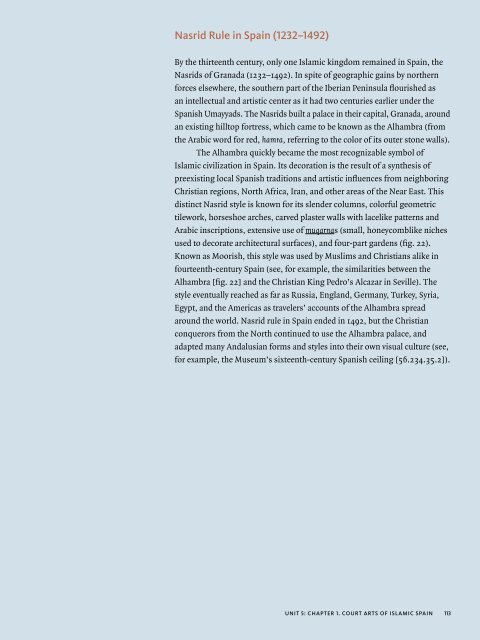Courtly Splendor in the Islamic World - The Metropolitan Museum of ...
Courtly Splendor in the Islamic World - The Metropolitan Museum of ...
Courtly Splendor in the Islamic World - The Metropolitan Museum of ...
Create successful ePaper yourself
Turn your PDF publications into a flip-book with our unique Google optimized e-Paper software.
nasrid rule <strong>in</strong> spa<strong>in</strong> (1232–1492)<br />
By <strong>the</strong> thirteenth century, only one <strong>Islamic</strong> k<strong>in</strong>gdom rema<strong>in</strong>ed <strong>in</strong> Spa<strong>in</strong>, <strong>the</strong><br />
Nasrids <strong>of</strong> Granada (1232–1492). In spite <strong>of</strong> geographic ga<strong>in</strong>s by nor<strong>the</strong>rn<br />
forces elsewhere, <strong>the</strong> sou<strong>the</strong>rn part <strong>of</strong> <strong>the</strong> Iberian Pen<strong>in</strong>sula flourished as<br />
an <strong>in</strong>tellectual and artistic center as it had two centuries earlier under <strong>the</strong><br />
Spanish Umayyads. <strong>The</strong> Nasrids built a palace <strong>in</strong> <strong>the</strong>ir capital, Granada, around<br />
an exist<strong>in</strong>g hilltop fortress, which came to be known as <strong>the</strong> Alhambra (from<br />
<strong>the</strong> Arabic word for red, hamra, referr<strong>in</strong>g to <strong>the</strong> color <strong>of</strong> its outer stone walls).<br />
<strong>The</strong> Alhambra quickly became <strong>the</strong> most recognizable symbol <strong>of</strong><br />
<strong>Islamic</strong> civilization <strong>in</strong> Spa<strong>in</strong>. Its decoration is <strong>the</strong> result <strong>of</strong> a syn<strong>the</strong>sis <strong>of</strong><br />
preexist<strong>in</strong>g local Spanish traditions and artistic <strong>in</strong>fluences from neighbor<strong>in</strong>g<br />
Christian regions, North Africa, Iran, and o<strong>the</strong>r areas <strong>of</strong> <strong>the</strong> Near East. This<br />
dist<strong>in</strong>ct Nasrid style is known for its slender columns, colorful geometric<br />
tilework, horseshoe arches, carved plaster walls with lacelike patterns and<br />
Arabic <strong>in</strong>scriptions, extensive use <strong>of</strong> muqarnas (small, honeycomblike niches<br />
used to decorate architectural surfaces), and four-part gardens (fig. 22).<br />
Known as Moorish, this style was used by Muslims and Christians alike <strong>in</strong><br />
fourteenth-century Spa<strong>in</strong> (see, for example, <strong>the</strong> similarities between <strong>the</strong><br />
Alhambra [fig. 22] and <strong>the</strong> Christian K<strong>in</strong>g Pedro’s Alcazar <strong>in</strong> Seville). <strong>The</strong><br />
style eventually reached as far as Russia, England, Germany, Turkey, Syria,<br />
Egypt, and <strong>the</strong> Americas as travelers’ accounts <strong>of</strong> <strong>the</strong> Alhambra spread<br />
around <strong>the</strong> world. Nasrid rule <strong>in</strong> Spa<strong>in</strong> ended <strong>in</strong> 1492, but <strong>the</strong> Christian<br />
conquerors from <strong>the</strong> North cont<strong>in</strong>ued to use <strong>the</strong> Alhambra palace, and<br />
adapted many Andalusian forms and styles <strong>in</strong>to <strong>the</strong>ir own visual culture (see,<br />
for example, <strong>the</strong> <strong>Museum</strong>’s sixteenth-century Spanish ceil<strong>in</strong>g [56.234.35.2]).<br />
unit 5: chapter 1. court arts <strong>of</strong> islamic spa<strong>in</strong><br />
113

















